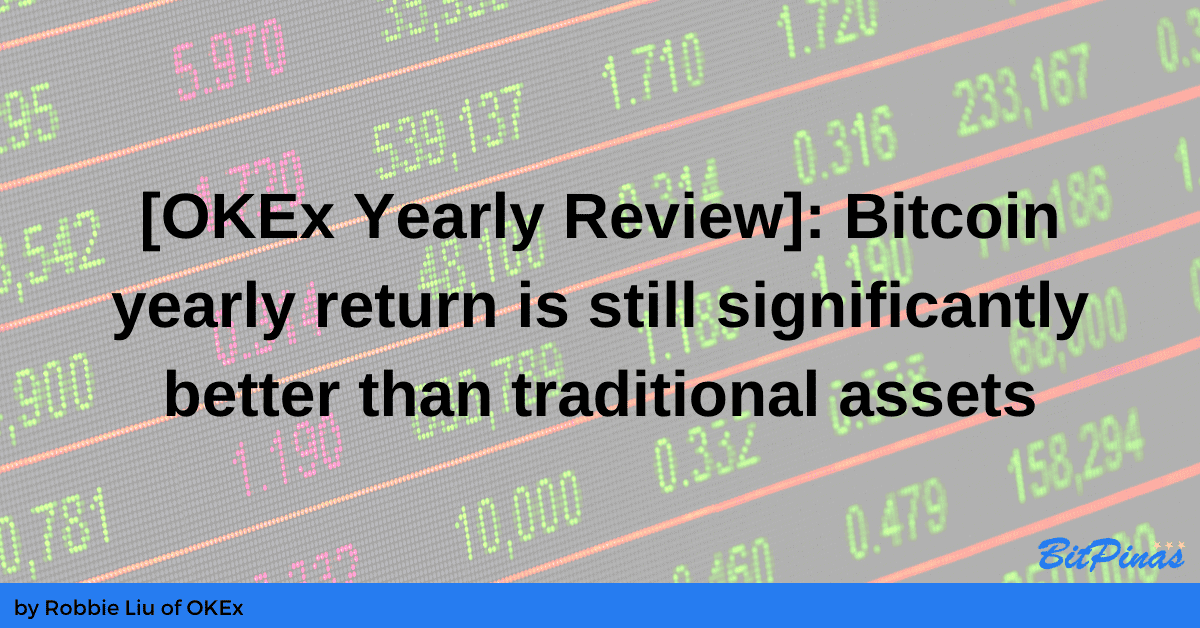Bitcoin yearly return is still significantly better than traditional assets
The third halving will occur in May 2020, and the block reward will be halved to 6.25 BTC. The total supply of Bitcoin is 21 million, and the proportion of Bitcoins mined by the end of this year is about 86%.

By Robbie Liu 2019/12/20
Happy Holidays to our readers from OKEx.
By the year end, we look back 2019 and find some interesting numbers to share with you. Yearly return of Bitcoin is significantly outperforming traditional assets, representing a more than 90% gain year to date as of December 26th. And returns on almost all asset classes have increased a lot this year. The S&P 500 has achieved a yearly return of 30%. Big market cap companies have boosted the S&P 500 index significantly. For example, Apple was the world’s largest listed company before the listing of Saudi Aramco, with a market value of $1.3 trillion. Apple shares are up 80% so far this year. In addition, crude oil price rose by 35.6%, gold rose by 17.3%, and the TLT ETF, which tracks the U.S. treasury bond yield, rose by 12.6% this year.

Historical return review:
Looking back at Bitcoin’s return over the past 6 years, we can see that 2019 is not a “big” year for this emerging asset class, especially the Christmas tree-like price line made many market participants not really gain too much returns. But people who have experienced the bear market in 2018 will still be happy, after all, this year is not the endless downtrend.
From the quarterly return chart, we can find that the first quarter is obviously the worst performer among four quarters. It is difficult for us to put much hope on the beginning of next year. The second quarter has always been the best quarter with the highest average return. In addition, the third bitcoin halving will occur in May 2020, so we are looking forward to the second quarter of 2020.


Bitcoin price in 2019:
Bitcoin found the bottom in the first quarter of this year and completed a rising wave at the beginning of the second quarter. Market participants had a lot of discussions on the relationship between the price rise of bitcoin and macroeconomic factors in the second quarter. At that time, the Sino-US trade war was fierce, global negative interest rate bonds were growing, and the U.S. bond yield curve was inverted. The passive global economic outlook increased the market’s demand of Safe-Haven Assets. The price of gold and US treasury bonds rose sharply, and so does Bitcoin benefit from the “digital gold” narrative. And this risk-averse mood reached its highest point at the end of June.
Later, it is interesting that these macro factors reversed in early September, which also caused the price of gold to decline after peaking in early September. Since Bitcoin peaked at the end of June, this time difference makes us think that the macro factors are still only a small part that affects the price of Bitcoin.
Bitcoin once again fell off the $ 10,000 at the end of the third quarter and hit $ 7,300 at the end of October. On October 25, Chinese leader Xi Jinping declared blockchain “an important breakthrough, which suddenly push the price to above $ 10,000 in the last weekend of October. However, we found that the USDT traded on the RMB OTC market did not show a high premium at the time. And BTC / USDT also did not have a high premium with the US dollar price, which laid a foreshadowing for the subsequent decline of Bitcoin.
At the end of October, the Fed completed the third and final rate cut this year. The three major US stock indexes also hit a record high in November, which reduced the interests for funds to invest in emerging asset classes. The positive news from Chinese leader also failed to support Bitcoin price. Bitcoin finally fell below the bull-bear boundary of the 200-day moving average in mid-November and fell all the way to the $ 6500 level before it was supported. At the same time, the trading volume around various exchanges dropped significantly, indicating that retail interest has fallen simultaneously.
At present, Bitcoin price is around $ 7200. It is still difficult to tell whether the rebound from $ 6500 in December is a potential double bottom pattern. Confirmation of this pattern requires that the price breaks through the $ 7800 to $ 8100 range.
Bitcoin halving outlook for 2020:
The third halving will occur in May 2020, and the block reward will be halved to 6.25 BTC. The total supply of Bitcoin is 21 million, and the proportion of Bitcoins mined by the end of this year is about 86%. “Halving” seems to be a lot of output decline, but the percentage of newly mined Bitcoin in the total market value is relatively small. However, between the first halving and the second halving of Bitcoin, the price has increased by 55 times; since the second halving to today, the price has increased by about 12 times.
Happy Trading
Disclaimer: Trading digital assets involves significant risk and can result in the loss of your invested capital. You should ensure that you understand the risk involved and take into consideration your level of experience, investment objectives and seek independent financial advice if necessary.
This article is published on BitPinas: [OKEx Yearly Review]: Bitcoin yearly return is still significantly better than traditional assets




